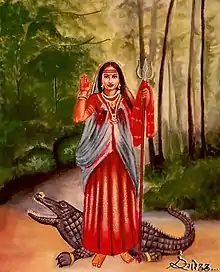Khodiyar
Khodiyar is a Hindu goddess worshiped mainly by Charan-Gadhvi community in the Gujarat and in some parts of Rajasthan in India.[1] The suffix Mata or Maa (meaning "mother") is generally added to her name, similar to other Hindu goddesses.
| Khodiyar | |
|---|---|
 | |
| Other names | Janbai, Khodal |
| Affiliation | Devi, Parashakti |
| Mantra | Om aim hrim klim shrim kham khodiyaray namah: |
| Weapon | Trident |
| Mount | Crocodile |
| Personal information | |
| Born | Rohishala Village, Botad Taluka, Bhavanagar |
| Parents | Mamadiya Gadhvi and Minalde Gadhvi |
| Siblings | Sisters : Aval, Jogal, Togal,Holbai, Beejbai, Sosai Brother : Mehrak |
Legend
The legend of the Khodiyar is around 700 AD. A man called Mamadiya Gadhvi (Mamadji Charan) lived in the Roishala village in Bhavnagar district.[1] He had good relations with the then ruler Maharaj Shilbhadra. The ruler's ministers envied this exceptional relationship and hatched a plan to get rid of Mamadiya. They were not very successful at persuading the king, but they succeeded in persuading his queen.
One day, the doorkeepers did not let Mamadiya go into the palace. When Mamadiya asked for the reason, he was told that a childless man is not worthy of the king's presence. Mamadiya returned home and prayed to the god Shiva for progeny and decided to perform "Kamal pooja" by sacrificing his life. Just when he was about to kill himself, Shiva appeared and took him to the Snake Kingdom – Nagaloka to see the King of Snakes – Nagadev.
After hearing his story, the Nagadev's youngest daughter and her seven siblings decided to help. The youngest daughter advised him to make eight cradles for eight children. Later due to the boon of Shiva and Nagadev, he was blessed with seven daughters (one being Janbai alias Khodiyar) and a son. The children were raised as fearsome warriors and always wore black cloths in memory of their native place, Nagaloka. Therefore, they were given the names as cobra sisters or Nagnechi, who was also the tutelary deity of the royal house of the erstwhile Marwar state.
Janbai saved her brother's life who was bit by a venomous bite by journeying underwater to Nagaloka and returned with amrita (the elixir of life) with her. Janbai suffered an injury to the foot and could not walk properly so she rode a crocodile back to the surface, earning her divine status. She was known as Khodiyar from the word khodi (limping) and the crocodile began her mount.[1]
Temples
The most important Khodiyar Mata temple are the temples at– Matel(near Wankaner), Rajpura village(near Bhavnagar), Galdhara(near Dhari) and tataniya dhara(near Bhavnagar).
Khodaldham is massive construction temple of "maa khodiyar" approximate area of 50 vigha.[2] It is located near Kagvad [Gujarat, 360370], off Jetpur-Virpur road section on NH27. It is located close to Khambalida Buddhist caves.
Khodiyar's temple at Matel near Wankaner is huge and people gather on the riverbank near the temple to see a crocodile, the goddess' mount. The place is located about 17km north of Wankaner, and 26km southeast of Morbi.
Sprawling Khodiyar Mataji temple at Rajpara village (Rajpara Dham) is equally popular. It is located about 18 km west of Bhavnagar city. There is a lake near the temple known as Tataniya Dharo, and for the same reason, goddess is also known as Tataniya Dharawali.
Galadhara Shree Khodiyar Mandir near Dhari, Gujarat is equally massive and popular.
A Gujarati film Jai Khodiyar Maa, was once a box office hit and Hemant Chauhan has a garba CD with the same title.
Kuldevi
Many Hindu castes like jograna (Bharvad) Charan, Bania,Brahmin and Patel, Bhoi etc worship Khodiyar Mata as their Kuldevi and also use Khodiyar as their surname.The Jograna(Bharvad) Chudasama, Patidar Sarvaiya, Rana, Raval(yogi), Bhati (Jaisavat/Jaisa), Rathod clans sometimes used Khodiyar as their surname as they worship Khodiyar Mata as their Kuldevi.[3]
References
- "Khodiyar Mata: The goddess rules a stepwell". Retrieved 4 March 2020.
- http://khodaldhamtrust.org
- Kadia Kshatriya Itihas Published by Nutan Prakashan (1895) in Gujarati